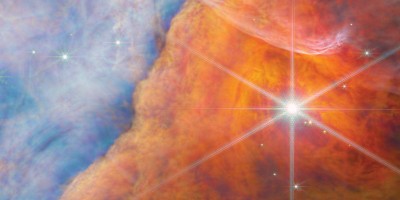Cosmic dust contains all the elements needed for life but has previously been considered too rare to have acted as a ‘fertilizer’ for prebiotic chemistry. Now, using a combination of astrophysical and geological models, it is revealed that cosmic dust could have gently accumulated on the surface of early Earth in sufficient quantities to promote the chemical reactions that led to first life.

References
Walton, C. R., Rimmer, P. & Shorttle, O. Can prebiotic systems survive in the wild? An interference chemistry approach. Front. Earth Sci. https://doi.org/10.3389/feart.2022.1011717 (2022). A review article that examines the difficulty and opportunity of evaluating origin-of-life scenarios using their geological contexts.
Love, S. G. & Brownlee, D. E. Heating and thermal transformation of micrometeoroids entering the Earth’s atmosphere. Icarus 89, 26–43 (1991). This classic paper reports a robust estimate of the cosmic dust accretion flux to Earth today.
Ritson, D. J., Mojzsis, S. J. & Sutherland, J. D. Supply of phosphate to early Earth by photogeochemistry after meteoritic weathering. Nat. Geosci. 13, 344–348 (2020). A research article that reveals extraterrestrial materials may plausibly have participated in prebiotic chemistry.
Pearce, B. K. D., Pudritz, R. E., Semenov, D. A. & Henning, T. K. Origin of the RNA world: the fate of nucleobases in warm little ponds. Proc. Natl Acad. Sci. USA 114, 11327–11332 (2017). An earlier modelling study that argues against the prebiotic relevance of cosmic dust but does not consider the role of sedimentary concentration processes.
Kadoya, S., Krissansen-Totton, J. & Catling, D. C. Probable cold and alkaline surface environment of the Hadean Earth caused by impact ejecta weathering. Geochem. Geophys. Geosyst. 21, e2019GC008734 (2020). A modelling study that supports the thesis of a cold start for life on Earth.
Additional information
Publisher’s note Springer Nature remains neutral with regard to jurisdictional claims in published maps and institutional affiliations.
This is a summary of: Walton, C. R. et al. Cosmic dust fertilization of glacial prebiotic chemistry on early Earth. Nat. Astron. https://doi.org/10.1038/s41550-024-02212-z (2024).
Rights and permissions
About this article
Cite this article
Cosmic dust may have driven the geochemical origins of life on Earth. Nat Astron 8, 554–555 (2024). https://doi.org/10.1038/s41550-024-02213-y
Published:
Issue Date:
DOI: https://doi.org/10.1038/s41550-024-02213-y
- Springer Nature Limited


